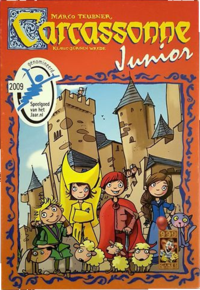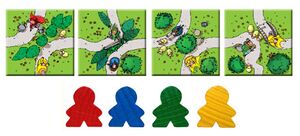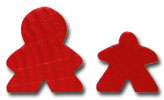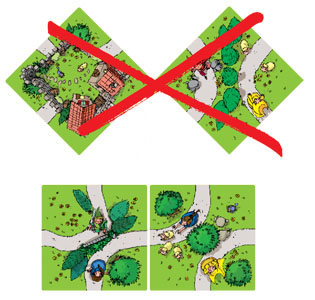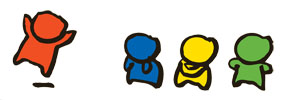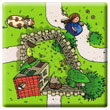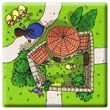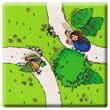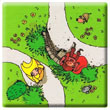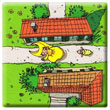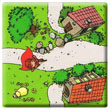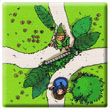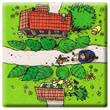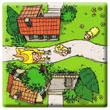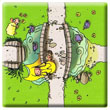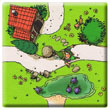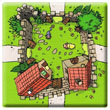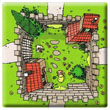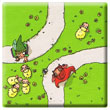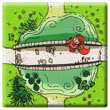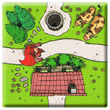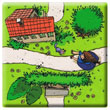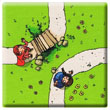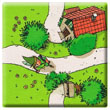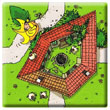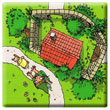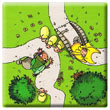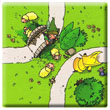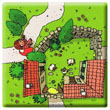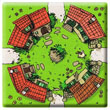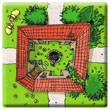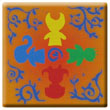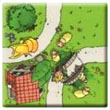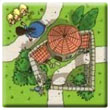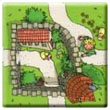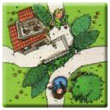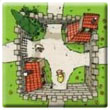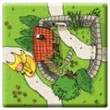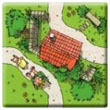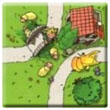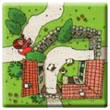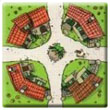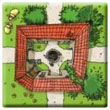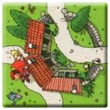Carcassonne Junior
Hoofdpagina > Carcassonne Junior > Carcassonne Junior
| Op 14 juli, de nationale feestdag, viert het Franse volk feest. In Carcassonne vieren de mensen dat door de schapen, kippen en koeien vrij te laten. De kinderen van Carcassonne hebben een geweldige tijd om de dieren weer terug te brengen, voordat de duisternis valt. |
Oorspronkelijk in Template:Year nl door Hans im Glück uitgegeven onder de titel Die Kinder von Carcassonne, en oorspronkelijk in het Engels vertaald als The Kids of Carcassonne (RGG Template:Year nl). Voor de eerste uitgave in Template:Year nl van ZMG werd het hernoemd naar My First Carcassonne. De meeste niet-Engelse versies staan bekend als Carcassonne: Junior.
Dit tweede ontwerp van ZMG, met herziene illustraties werd in Template:Year nl uitgegeven, samen met bijgewerkte uitgaven voor de meeste andere markten.
Een leuk en opwindend tegellegspel voor 2-4 spelers van 4 jaar en ouder van Marco Teubner. Dit is de kindereditie van het spel Carcassonne van Klaus-Jürgen Wrede.
Speelmateriaal
- 36 landtegels (70mm x 70mm - ongeveer twee keer zo groot als normale Carcassonne tegels)
- 32 speelstukken (8 per kleur) - groter dan meeples van Carcassonne (kinderen van Carcassonne)
Voorbereiding
Neem alle tegels, schud ze en maak verschillende stapels met de tegels. Verspreid de stapels rond de tafel zodat elke speler tenminste één stapel binnen handbereik heeft.
Zorg dat er in het midden van de tafel voldoende ruimte is omdat je daar een stad gaat bouwen met de tegels.
Elke speler kiest een kleur en neemt de 8 speelstukken van die kleur en zet ze voor zich neer. Als je met minder dan 4 spelers speelt, doe dan de niet gekozen kleuren terug in de doos.
Draai de bovenste tegel van één van de gedekte stapels om en leg deze open midden op tafel. Deze tegel is de starttegel voor het spel. Aan deze tegel ga je verder tegels aanleggen.
Doel van het spel
Tijdens het spel bouw je Carcassonne door tegels aan te leggen. De eerste speler die al zijn kinderen van Carcassonne op het landschap heeft gezet wint het spel.
Spelverloop
Er wordt met de klok mee gespeeld, te beginnen met de startspeler, die willekeurig gekozen wordt.
Landtegel leggen
In je beurt draai je de bovenste tegel van één van de gedekte stapels om en legt deze aan het landschap dat al op tafel ligt. Daarbij moet de tegel aan ten minste één zijde van één of meer tegels van het landschap grenzen.
Het is niet toegestaan om tegels uitsluitend met de hoeken aan elkaar te leggen.
Kinderen op tegels zetten
Op de wegen (op elk van de tegels), staan illustraties van kinderen in de vier kleuren van de speelstukken.
Telkens als een speler een tegel zodanig aanlegt dat een weg aan beide zijden wordt afgesloten, mogen de spelers wiens kleuren op delen van de afgesloten weg staan hun speelstukken daarop zetten. Elk wegdeel met een kleur in de spelerskleur van een speler die in het spel is, mag een speelstuk zetten. Een weg is afgesloten als die, aan beide zijden, eindigt bij een meer, een weg een huis of een weide.
Een weg is ook afgesloten als die een lus vormt.
Als een deel van een afgesloten weg een kleur heeft die geen van de spelers gebruikt, wordt daar niets neergezet.
Einde van het spel
Zodra een speler al zijn speelstukken op het speelveld heeft mogen zetten, eindigt het spel. Deze speler wint het spel.
In rare cases it can happen that all tiles are played, but no player has played all their figures. In this case, the game ends when the last tile is played. In this case, the winner is the player who has the fewest figures left unplayed on the map. If players tie with the fewest, those tied rejoice in their shared victory.
| At the end of the day, the children return home, exhausted, but with stories of their wonderful experiences from the long day. The day concludes with a multi-coloured celebration with large bonfires and tasty foods from the area around Carcassonne. People of all ages join in the celebration. The elders entertain the children with exciting tales of knights, fairies, and dragons. The children listen with rapt attention to the dreams of ancient time and with hopes that they will have similar adventures one day. Finally, most children fall asleep, while the animals enjoy peace again in their stables. The animals, which were not caught by the children, return in the evening to join the other animals. Their returns are welcome because the children of Carcassonne are concerned for the safety of their sheep, dogs, cats, and chickens ... |
Credits
Illustration: Rolf Vogt
Tegelverdeling
Totale aantal normale tegels: 36
Achterkant van de tegel
German/French First Edition tiles
The initial release of the German and French versions (both by HiG) contained an imbalance in the number of children, in each colour, printed on the tiles. There were 12 green, 12 yellow, 11 red and 10 blue children. In the second printing, this was corrected to 11 of each.
Additionally, a number of tiles featured roads passing through the inner courtyards of the buildings, which were replaced in the second version with roads which stopped at the buildings. All other printings from around this time contained the correct tile images. There were also some minor artwork changes as well - green children have pointed hats. The tiles from that original printing are included below, with the tiles that replaced them.
Total Regular Tiles: 14
Voetnoten
Ga voor licentie en uitleg over de pictogrammen naar de pictogrammen pagina.
